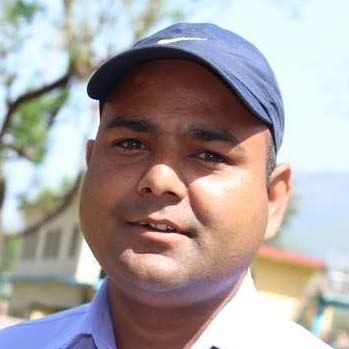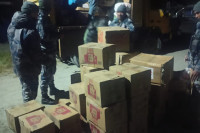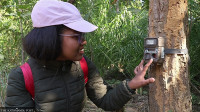National
Yarsagumba pickers rue shrinking harvests as winters grow warmer
Families now have to trek longer and higher for smaller yields of the caterpillar fungus, prized for purported medicinal value.
Krishna Prasad Gautam
When Dan Bahadur Giri looks at his village in Sukadhik in ward 8 of Khatyad Rural Municipality in Mugu district, he says it no longer resembles the place he grew up in. “Until 2000, we would have snowfall four to five times every winter. Without snow, the surrounding hills now remain dry even in peak winter. Water springs have begun to dry and water scarcity has become the norm,” he said. While vegetables and fruits once grown only in the Tarai now grow in the highlands due to rising temperatures, the iconic Himalayan apples have seen a sharp decline in production.
The changes have not stopped with crops. Giri complains that medicinal herbs that once sustained mountain livelihoods—such as morel mushrooms, red mushrooms, jatamasi, kutki, satuwa and sugandhawal—have begun disappearing from their traditional habitat. For three decades, Giri has trekked to the alpine pastures of Sanu Koiki, Thulo Koiki, Rimar, and Tanke in Mugum Karmarong to harvest yarsagumba, known as Himalayan caterpillar fungus. But he has been noticing a troubling shift. “The lower slopes no longer receive enough snow, and yarsagumba has started appearing only higher up,” he said. “Every year it shifts upward by one or two feet.”
Yarsagumba (Cordyceps sinensis) is a medicinal fungus known for its purported aphrodisiac properties and sometimes dubbed ‘Himalayan Viagra’.
Karma Tamang, aged 59, from ward 4 of Dolpobuddha Rural Municipality in neighbouring Dolpa district, echoes the same concern. His family has depended on yarsagumba collection for roughly 15 years, trekking to Ruppatan, Chinarangsi, Majhdanda, Batulile, Phuke, and other high pastures each spring. A decade ago, the four members of his family earned between Rs300,000 to Rs500,000 a season. Last year, Tamang barely earned Rs150,000.
“If we don’t get enough snow, we don’t get enough yarsagumba. Today we only find it in the uppermost sections of the pastures. The lower belt has stopped producing altogether,” said Tamang.
A study conducted two years ago by Mugum Karmarong Rural Municipality, with support from various organisations, concluded that declining snowfall was directly affecting the reproductive cycle of the fungus. The study also pointed to increased pollution in the pastures and human activities that have altered the micro-ecosystem.
Min Bahadur KC, a former forest officer who participated in the study, said yarsagumba production has become unpredictable. “In many places, the spot where yarsagumba appeared one year produced nothing the next,” he said. “Snow is central to its life cycle. In natural conditions, the larvae of the ghost moth remain underground while the fungal growth emerges above ground once the snow melts in April.”
Heavy grazing has also degraded habitat in the lower pastures, further reducing yield.
Researchers have recorded a clear pattern: yarsagumba, traditionally found between 3,000 and 5,500 metres above sea level, is now rarely found below 4,000 metres. Laxman Sharma, who studies yarsagumba ecology, said rising winter temperatures have been catastrophic. “The larvae need to mature under snow cover,” he explained. “But with less snowfall, the larvae fail to survive in lower altitudes. Meanwhile, harvesting with digging tools has degraded the soil structure and damaged the natural habitat, further lowering production.”
For families in mountain districts such as Mugu and Dolpa, the economic consequences have been severe. In Sukadhik, Takka Dangar said the decline has shaken the community’s survival. “No one here holds government jobs, and the annual harvest from our farms barely feeds us for three months. Medicinal herbs have been our livelihood for generations,” he said. His family of five now collects yarsagumba after reaching deep into the alpine zones every year. But the returns continue to shrink.
“If the snowfall is good, we can collect enough. But now, even five people working all day hardly collect more than 10 to 15 pieces,” said Dangar. “A family spends at least Rs50,000 to Rs60,000 just to go to the pastures, but earnings barely exceed Rs150,000.” Many villagers now migrate seasonally to district headquarters such as Gamgadhi to work as labourers. Dangar added that apples, once a reliable cash crop in Mugu, have also stopped growing due to warmer winters.
According to Ramesh Kumar Giri, divisional forest officer at the Ministry of Industry, Tourism, Forest and Environment of Karnali Province, snowfall cycles in the Himalayan districts have visibly weakened over the years. He explained that yarsagumba’s life cycle is unusually complex and entirely dependent on uninterrupted snow cover. “A species of moth lays eggs in December-January. The eggs hatch under snow, and by February-March larvae develop underground. The fungus parasitises the larvae and emerges from the soil in May,” he said. When collectors, according to him, harvest immature specimens before the reproductive cycle completes, future populations decline rapidly.
Experts point out the climate change impacts behind the dwindling yarsagumba harvest. Climate scientist Manish Acharya said the temperature shift is now visible even in the high mountains. “With reduced precipitation, Himalayan landscapes heat up faster, melting whatever snow remains,” he said. “Without snowfall, new snow systems do not develop. The impact is direct—agricultural productivity falls, ecosystems degrade, and high-value herbs like yarsagumba decline sharply.”
Even as yarsagumba yields fall, prices continue to increase. Collectors in the high pastures sell yarsagumba at around Rs1,000 per piece. In Chharkatangsong of Dolpa, trader Parbal Lama said he sold yarsagumba for around Rs2.7 million per kilogram this year, compared to Rs2.2-2.5 million last year. “China remains the biggest market. If Nepali traders could export directly, we would get even higher prices,” he said. “But with lower snowfall, high-quality yarsagumba are becoming rare, and the price difference is visible.” One kilogram of good-quality yarsagumba contains between 2,500 and 4,000 pieces, and Lama said prices in China can reach up to Rs6 million per kg.
Karnali province exported approximately 214 kg of yarsagumba last year, according to provincial forestry data. Provincial Minister for Industry, Tourism, Forest and Environment Suresh Adhikari said work is underway to develop a strategic plan to make yarsagumba collection safer, climate-resilient, and better integrated with market systems. “To strengthen the provincial economy, we must protect our medicinal herb wealth,” he said. “Through tourism, herbal cultivation, and organised marketing, we aim to increase employment, economic activity, and long-term prosperity in Karnali.”




 19.12°C Kathmandu
19.12°C Kathmandu















